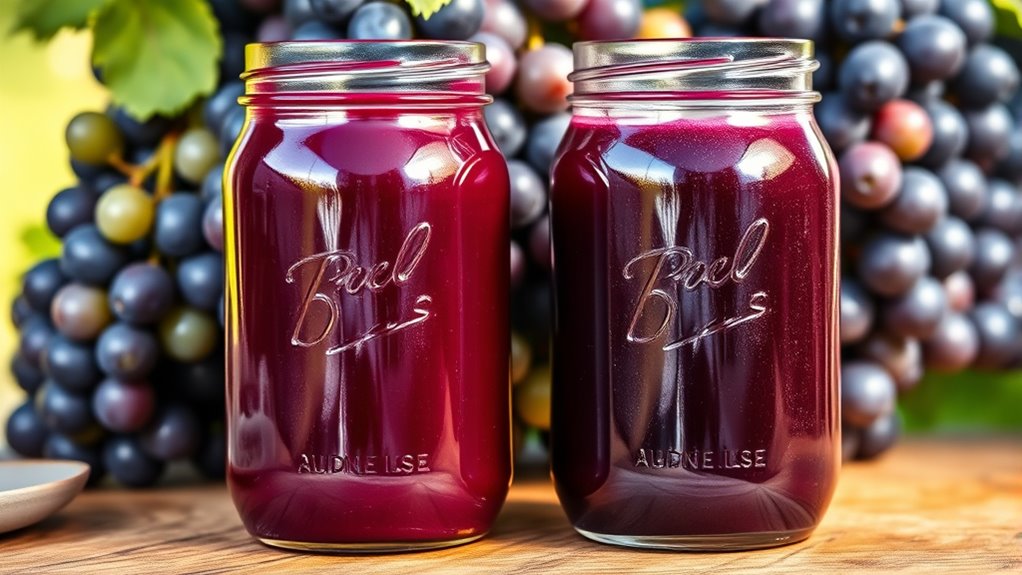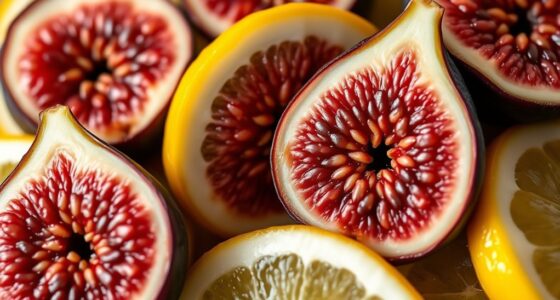Concord and muscadine grape juices each have unique flavors, nutritional perks, and cultural roots. Concord juice offers bright, tangy, berry-like taste, while muscadine provides richer, earthier, musky notes. Both are rich in antioxidants that support your heart and immune system, but muscadine typically has higher resveratrol levels. Their origins influence their flavors and uses, from traditional celebrations to health benefits. To discover which suits your taste and health goals best, explore further details below.
Key Takeaways
- Concord grapes have bright, tangy flavors with berry notes, while Muscadines offer richer, musky, and earthy taste profiles.
- Concord juice is higher in polyphenols, whereas Muscadine juice contains more resveratrol, impacting their antioxidant benefits.
- Concord grapes originated in northeastern U.S., while Muscadines are native to southeastern U.S., reflecting regional cultivation differences.
- Both juices support heart health and immune function through high antioxidant content, but their phytochemical profiles vary.
- Proper storage and minimal processing help preserve the nutritional and flavor qualities of both Concord and Muscadine grape juices.
Origins and Cultivation of Concord and Muscadine Grapes
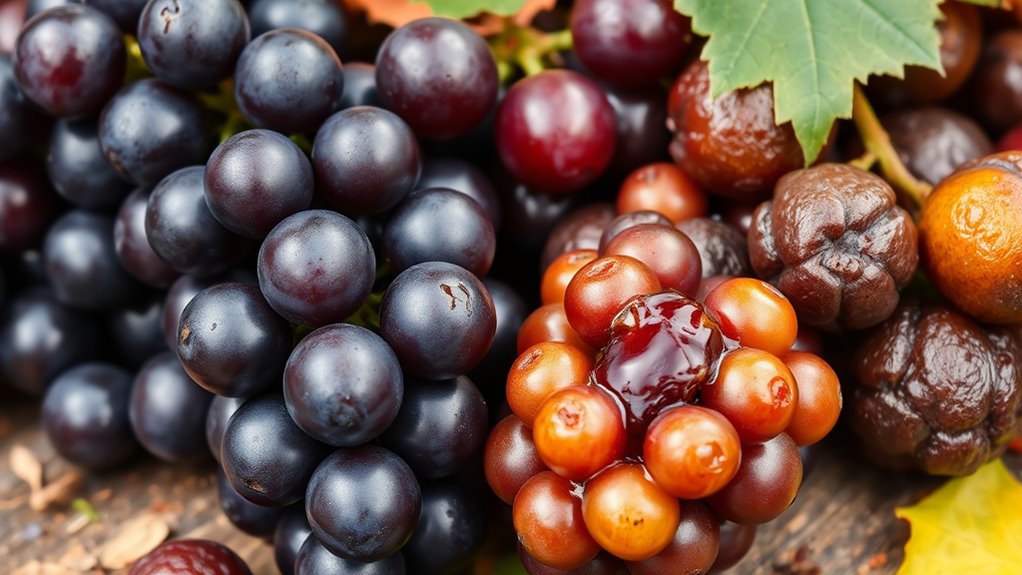
Concord and muscadine grapes have distinct origins and cultivation histories that highlight their unique characteristics. Concord grapes originated in the early 19th century in New York, with their historical spread spreading throughout the northeastern United States. They became popular due to their hardy vines and resistance to common pests, making cultivation easier in temperate climates. In contrast, muscadine grapes are native to the southeastern U.S., with a history rooted in indigenous cultivation. They face several cultivation challenges, such as sensitivity to cold and specific soil requirements, which limit their range. Growing muscadines demands careful attention to climate and soil conditions, while Concords benefit from a broader adaptability. Understanding these cultivation challenges and historical spread helps you appreciate why each grape has developed its own unique presence in American viticulture. Additionally, advancements in agricultural technology are helping growers overcome some of these cultivation challenges, expanding the potential for muscadine cultivation in new regions. Moreover, ongoing research into disease resistance is contributing to more resilient grape varieties, ensuring sustainable production for both types. Furthermore, climate adaptability plays a crucial role in determining the success of cultivating these grapes in various environments. Recent breeding techniques are also being employed to develop varieties that can better withstand environmental stresses. These innovations are also influenced by environmental considerations, which are increasingly important in modern agriculture.
Flavor Profiles and Taste Comparisons

When comparing the flavor profiles of Concord and muscadine grapes, you’ll notice distinct differences that influence how they’re used in juices and other products. Concord grapes offer bright, tangy flavors with prominent berry and grape notes, along with subtle acidity. Muscadines, however, provide richer, deeper flavor nuances, including sweet, musky, and earthy undertones, often described as more robust. These taste differences impact their versatility in juice production. Additionally, understanding flavor profiles is essential for product development and marketing strategies. Recognizing these distinct taste differences helps producers tailor their products to meet consumer preferences and highlight each grape variety’s unique qualities. The unique aroma profiles of each variety also play a significant role in consumer appeal and branding. Moreover, the marketability of these juices is often influenced by their sensory characteristics, making flavor differentiation important for branding. Exploring consumer preferences can further refine how these flavors are marketed to target audiences.
Nutritional Benefits and Health Properties

Grape juices are packed with antioxidants that help protect your cells from damage, supporting overall health. They also promote heart health by improving circulation and lowering blood pressure. Plus, their rich vitamin content can give your immune system a helpful boost, keeping you resilient against illnesses. Additionally, the presence of antioxidants in grape juice supports skin health and may slow signs of aging. Research indicates that the nutritional profile of these juices can contribute to overall wellness and disease prevention. Incorporating natural fruit juices into your diet can further enhance these health benefits and support a balanced lifestyle. Furthermore, the application methods of different juicing techniques can influence the preservation of beneficial nutrients. To maximize health benefits, choosing freshly squeezed grape juice over processed options is recommended.
Antioxidant Powerhouse
Have you ever wondered why grapes are considered a nutritional powerhouse? It’s because they’re packed with antioxidants like resveratrol and flavonoids, which help fight free radicals and reduce oxidative stress. Drinking grape juice can boost your immune system and protect your cells from damage. To maximize these benefits, try pairing your juice with antioxidant-rich foods like nuts or dark chocolate. Proper storage tips are essential—keep your juice refrigerated in an airtight container to preserve its antioxidant properties and prevent spoilage. Freshly squeezed or high-quality store-bought juice retains more nutrients, so always check labels and consume promptly. Additionally, choosing sulfate-free options ensures you’re avoiding additives that can diminish the health benefits of your grape products. Proper storage and selection of high-quality, halal-certified grape products ensure that your consumption aligns with halal lifestyle principles. Incorporating quality control measures can further guarantee the purity and nutritional integrity of your grape juice, allowing you to harness its full antioxidant power. Using advanced testing techniques can help verify the antioxidant content and overall quality of the juice product.
Heart Health Support
Ever wonder how grapes support your heart health? The answer lies in their rich antioxidants and beneficial compounds. Winemaking techniques influence the concentration of polyphenols, which are linked to cardiovascular benefits. For example, minimal processing during grape harvesting methods preserves these nutrients, ensuring you get maximum health support. Concord and Muscadine grapes are harvested at peak ripeness to optimize their natural heart-friendly properties. These grapes contain resveratrol and flavonoids that help reduce inflammation and improve blood vessel function. When you consume grape juices made from carefully harvested and processed grapes, you’re giving your heart essential nutrients that promote better circulation and lower risk of heart disease. So, the way grapes are grown and processed directly impacts their ability to support your heart health. Cookie preferences and data collection practices can also influence how you experience personalized health benefits from digital resources and products.
Immune System Boost
Because of their high levels of vitamin C, antioxidants, and phytochemicals, grape juices can substantially strengthen your immune system. These nutrients help combat free radicals and reduce inflammation. The fermentation methods used in processing, such as cold fermentation, preserve more antioxidants, boosting health benefits. Proper storage techniques, like refrigeration and avoiding light exposure, maintain nutrient integrity. Different grape varieties offer varying phytochemicals; Muscadine grapes, for example, contain higher resveratrol levels, enhancing immune support. To maximize benefits, choose fresh, minimally processed juices and store them correctly. Cost behavior analysis can help understand how storage and processing impact nutrient preservation. Incorporating either Concord or Muscadine juice into your diet can bolster your defenses naturally.
Antioxidants and Phytochemicals in Each Juice

You’ll notice that different grape juices boast varying levels of antioxidants, making some more potent for your health than others. Each juice also contains unique phytochemicals that contribute to its specific benefits. Understanding these differences helps you choose the best options for your wellness goals. For example, Concord grape juice is known for its high levels of antioxidants, which can help combat oxidative stress and support overall health. Additionally, the presence of insurer’s financial stability in the evaluation process ensures that your investment in the juice’s health benefits remains reliable over time. Recognizing the vibrational energy associated with each type of grape juice can further enhance your ability to attract optimal health benefits through the Law of Attraction.
Antioxidant Levels Comparison
When comparing the antioxidant levels in grape juices, it’s clear that the variety and processing methods substantially influence their phytochemical content. Concord juice typically boasts higher grape polyphenol content, making it rich in antioxidants that combat oxidative stress. Muscadine juice, however, often has a notable flavonoid concentration, which enhances its health benefits. The way the juices are processed also impacts their antioxidant levels; minimal filtration preserves more phytochemicals. You’ll find that Concord’s robust flavor correlates with its higher polyphenol levels, while Muscadine’s unique profile offers a different antioxidant spectrum. Overall, both juices provide valuable antioxidants, but their specific phytochemical profiles are shaped by grape variety and processing techniques, influencing their potential health benefits.
Unique Phytochemical Profiles
The unique phytochemical profiles of grape juices reflect their specific antioxidant compounds and other bioactive substances, which vary based on grape variety and processing methods. These differences influence health benefits and flavor.
- Concord juice is rich in resveratrol and anthocyanins, enhancing its antioxidant power.
- Muscadine juice contains higher levels of ellagic acid, which offers unique benefits.
- Proper storage methods preserve these phytochemicals, while fermentation benefits can boost certain antioxidants, making the juice more potent.
Understanding these profiles helps you choose the right juice for your health goals. Fermentation can increase bioavailability of phytochemicals, and storing juices in airtight containers minimizes nutrient loss. Whether you prefer Concord or Muscadine, their distinct phytochemical compositions provide specific antioxidant benefits tailored to your needs.
Cultural Significance and Popular Uses
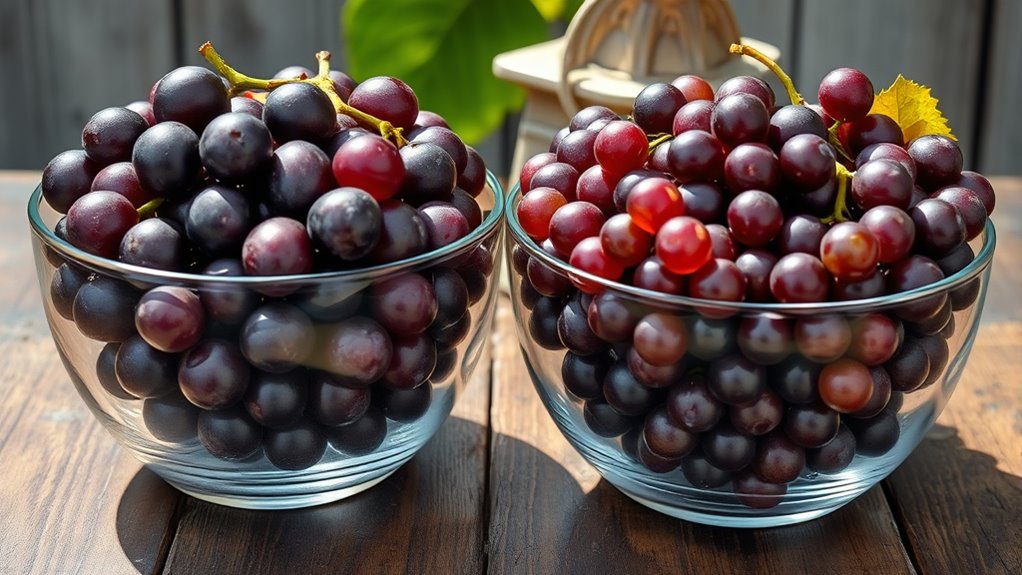
Grape harvest juices hold deep cultural significance across many societies, symbolizing abundance, celebration, and tradition. In regions with rich winemaking traditions, these juices often serve as a starting point for fermentation, connecting communities to their heritage. During regional festivals, grape harvesting and juice sampling become central events, fostering social bonds and honoring agricultural practices. People use these juices in rituals, offerings, or as symbols of prosperity. They’re featured in cultural dishes, desserts, and beverages, reflecting local customs and tastes. For many, these juices are more than just drinks—they’re a way to celebrate the harvest season, preserve ancestral practices, and unite communities in shared history. Their role in cultural festivities underscores their importance beyond nutrition, embodying regional identity and tradition.
Tips for Selecting and Serving These Juices
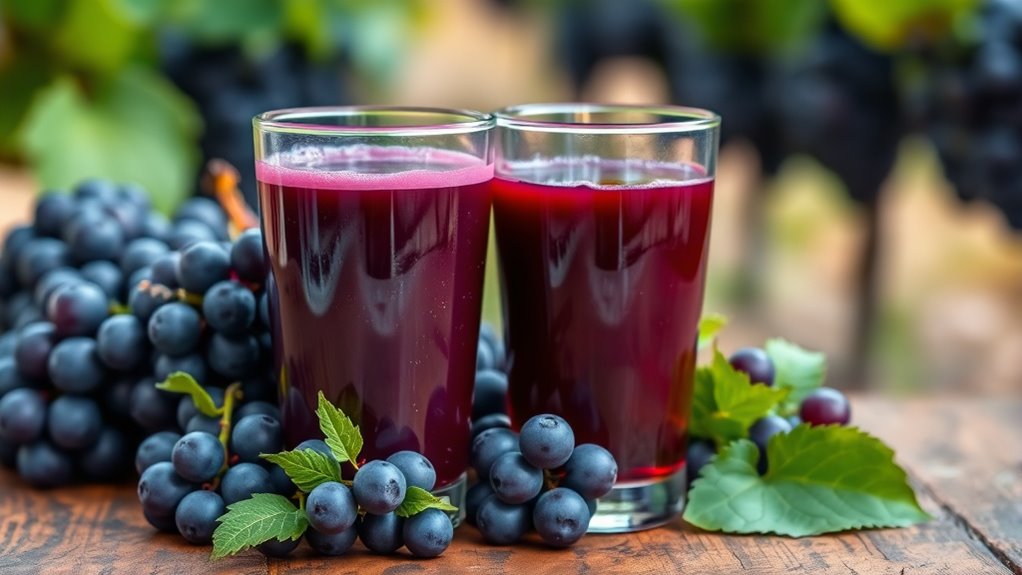
Choosing the right grape harvest juice can enhance your tasting experience and connect you further to its cultural roots. To do so, consider these tips:
- Pairing suggestions: Complement Concord juice with hearty cheeses or spicy dishes, while Muscadine pairs well with light salads or seafood.
- Storage tips: Keep unopened bottles in a cool, dark place. Once opened, refrigerate and consume within a few days to preserve crispness.
- Serving tips: Serve slightly chilled for a invigorating taste, or warm for a cozy experience. Glassware matters—use clear glasses to showcase the juice’s vibrant color.
Potential Allergies and Considerations
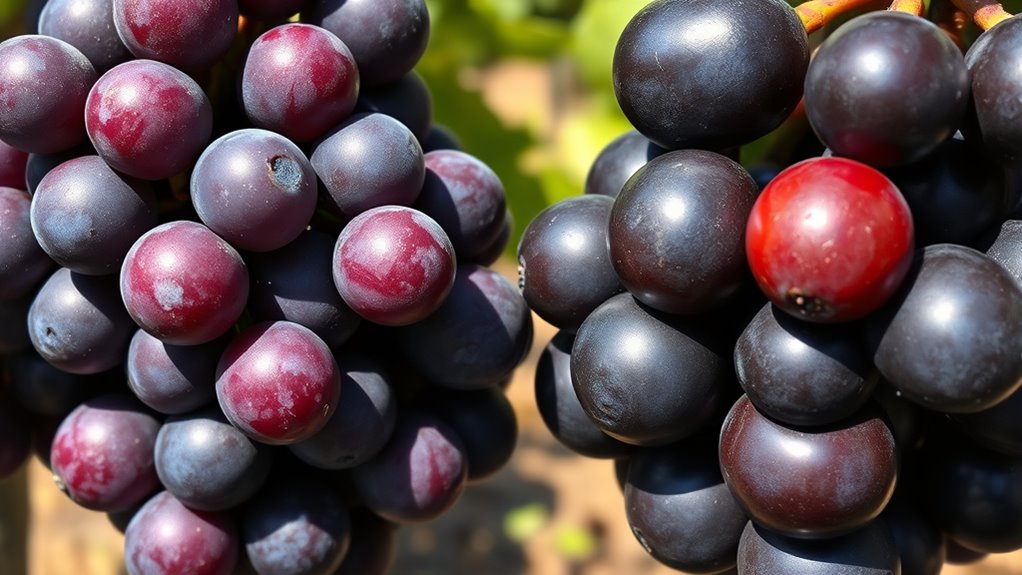
While grape harvest juices are generally enjoyed safely, it’s important to be aware of potential allergies and sensitivities. Some people may experience allergy symptoms like itching, swelling, or difficulty breathing after consuming grape juice. If you have a history of fruit allergies, especially to other berries or fruits, cross reactivity concerns might arise, increasing the risk of adverse reactions. It’s wise to start with small amounts and monitor your body’s response. Always check ingredient labels for added preservatives or allergens. If you notice any allergy symptoms, seek medical advice promptly. Being aware of these considerations helps ensure you enjoy grape juices without risking uncomfortable or dangerous allergic reactions. When in doubt, consult with a healthcare professional for personalized guidance.
Frequently Asked Questions
Which Grape Variety Is More Suitable for Organic Cultivation?
When choosing a grape variety for organic cultivation, consider pest resistance and how well it responds to organic practices. Muscadine grapes tend to be more suitable because they naturally resist pests and diseases, reducing the need for chemical treatments. Concords, while popular, often require more pest management. So, if you’re aiming for easier organic practices, Muscadine grapes might be the better choice, thanks to their inherent pest resistance.
How Do Storage Methods Affect Juice Quality Over Time?
Imagine your juice transforming into a flavorless, dull shadow of its vibrant self—that’s what poor storage can do. You need to control storage temperature and use proper pasteurization techniques to preserve the fresh taste and nutrients. Keep your juice cold and avoid rapid temperature shifts. Proper storage methods can substantially extend shelf life, ensuring every sip remains as delicious and nutritious as the day it was made.
Are There Specific Regions Known for Producing Premium Grape Juices?
You’ll find that certain regions are renowned for premium grape juices because of their unique regional terroirs and ideal harvest timing. Places like California’s Napa Valley and parts of Georgia benefit from specific soil types and climate conditions that influence grape quality. When you pay attention to harvest timing, you get fresher, more flavorful juices. These regional factors combine to produce juices that stand out in flavor and overall quality.
Can These Juices Be Used Effectively in Cooking or Baking?
Imagine pouring grape juice into a cake batter or sauce—you’re surprised how well it works! You can definitely use grape juices for cooking applications and baking uses, adding depth and sweetness. Whether it’s a glaze, marinade, or dessert, these juices enhance flavor naturally. So, don’t hesitate to experiment—your dishes will benefit from the vibrant, fruity notes that grape juices bring to the table.
What Are the Environmental Impacts of Cultivating Concord vs. Muscadine Grapes?
When you compare growing Concord and Muscadine grapes, you’ll notice differences in environmental impact. Concord grapes often require more water and pesticides, leading to higher pesticide runoff and water usage. Muscadines are more resilient, needing fewer chemicals and less water. By choosing Muscadines, you help reduce pesticide runoff and conserve water, making them a more sustainable option for environmentally conscious growers and consumers alike.
Conclusion
So, next time you reach for a grape juice, remember: whether it’s the regal Concord or the robust Muscadine, you’re still indulging in a fruit that’s packed with surprises. Ironically, what’s considered a simple refreshment can also be a powerhouse of antioxidants and history. So, sip away confidently—just don’t forget, the true flavor adventure lies in choosing your favorite, because even the simplest juices have a story worth savoring.
Susannah expertise lies in researching and compiling evidence-based content on juicing, nutrition, and overall health. She is committed to ensuring that The Juicery World offers accurate, up-to-date, and trustworthy information to empower readers to take control of their health. Susannah’s goal is to inspire individuals to embrace juicing as a way to nourish their bodies and live their best lives.

